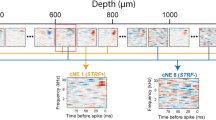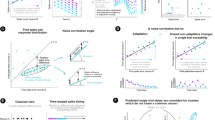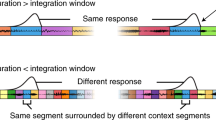Abstract
CORTICAL population coding could in principle rely on either the mean rate of neuronal action potentials, or the relative timing of action potentials, or both. When a single sensory stimulus drives many neurons to fire at elevated rates, the spikes of these neurons become tightly synchronized1,2, which could be involved in 'binding' together individual firing-rate feature representations into a unified object percept3. Here we demonstrate that the relative timing of cortical action potentials can signal stimulus features themselves, a function even more basic than feature grouping. Populations of neurons in the primary auditory cortex can coordinate the relative timing of their action potentials such that spikes occur closer together in time during continuous stimuli. In this way cortical neurons can signal stimuli even when their firing rates do not change. Population coding based on relative spike timing can systematically signal stimulus features, it is topographically mapped, and it follows the stimulus time course even where mean firing rate does not.
This is a preview of subscription content, access via your institution
Access options
Subscribe to this journal
Receive 51 print issues and online access
$199.00 per year
only $3.90 per issue
Buy this article
- Purchase on Springer Link
- Instant access to full article PDF
Prices may be subject to local taxes which are calculated during checkout
Similar content being viewed by others
References
Gray, C. M., Konig, P., Engel, A. K. & Singer, W. Nature 338, 334–337 (1989).
Singer, W. & Gray, C. M. A. Rev. Neurosci. 18, 555–586 (1995).
von der Malsburg, C. Internal report, Max Planck Institute for Biophysical Chemistry, Gottingen, Germany (1981).
Adrian, E. D. Electroenceph. clin. Neurophysiol. 2, 377–388 (1950).
Perkel, D. H., Gerstein, G. L. & Moore, L. Biophys. J. 7, 391–418 (1967).
Middlebrooks, J. C., Clock, A. E., Xu, L. & Green, D. M. Science 264, 842–844 (1994).
Abeles, M., Bergman, H., Margalit, E. & Vaadia, E. J. Neurophysiol. 70, 1629–1638 (1993).
Abeles, M. Corticonics: Neural Circuits of the Cerebral Cortex (Cambridge Univ. Press, New York, 1991).
Dickson, J. W. & Gerstein, G. L. J. Neurophysiol. 37, 1239–1261 (1974).
Eggermont, J. J. J. Neurophysiol. 71, 246–270 (1994).
Ts'o, D. Y., Gilbert, C. D. & Wiesel, T. N. J. Neurosci. 6(4), 1160–1170 (1986).
Ahissar, M. et al. J. Neurophysiol. 67, 203–215 (1992).
Nicolelis, M. A. L., Baccala, L. A., Lin, R. C. S. & Chapin, J. K. Science 268, 1353–1358 (1995).
Brugge, J. F. & Merzenich, M. M. J. Neurophysiol. 36, 1138–1158 (1973).
Creutzfeldt, O., Hellweg, F. C. & Schreiner, C. Expl Brain Res. 39, 87–104 (1980).
Pfingst, B. E. & O'Connor, T. A. J. Neurophysiol. 45, 16–34 (1981).
Mountcastle, V. B., Davies, P. W. & Berman, A. L. J. Neurophysiol. 20, 374–407 (1957).
Mountcastle, V. B. J. Neurophysiol. 20, 408–434 (1957).
Mountcastle, V. B., Talbot, W. H., Sakata, H. & Hyvarinen, J. J. Neurophysiol. 32, 452–484 (1969).
Hubel, D. H. & Wiesel, T. N. J. Physiol. Lond. 160, 106–154 (1962).
Maunsell, J. H. R. & Gibson, J. R. N. J. Neurophysiol. 68, 1332–1344 (1992).
Vaadia, E. et al. Nature 373, 515–518 (1995).
Gabbot, P. L. A. & Stewart, M. G. Neuroscience 21, 833–845 (1987).
Grannam, E. R., Kleinfeld, D. & Sompolinsky, H. Neural. Computat. 5, 550–569 (1993).
Murthy, V. N. & Fetz, E. E. Neural Comput. 6, 1111–1126 (1994).
Bernander, O., Koch, C. & Usher, M. Neural Computat. 6, 622–641 (1994).
Lehmann, E. L. Nonparametrics: Statistical Methods Based on Ranks (Holden-Day, San Francisco 1975).
Efron, B. The Jackknife, The Bootstrap, and Other Resampling Plans 75–87 (Society for Industrial and Applied Mathematics, Philadelphia, 1982).
Perkel, D. H., Gerstein, G. L. & Moore, G. P. Biophys. J. 7, 419–440 (1967).
Aertsen, A. M., Gerstein, G. L., Habib, M. K. & Palm, G. J. Neurophysiol 61, 900–917 (1989).
Author information
Authors and Affiliations
Rights and permissions
About this article
Cite this article
deCharms, R., Merzenich, M. Primary cortical representation of sounds by the coordination of action-potential timing. Nature 381, 610–613 (1996). https://doi.org/10.1038/381610a0
Received:
Accepted:
Issue Date:
DOI: https://doi.org/10.1038/381610a0
This article is cited by
-
The structures and functions of correlations in neural population codes
Nature Reviews Neuroscience (2022)
-
An emergent neural coactivity code for dynamic memory
Nature Neuroscience (2021)
-
Information diversity in individual auditory cortical neurons is associated with functionally distinct coordinated neuronal ensembles
Scientific Reports (2021)
-
Reconfigurable nanophotonic silicon probes for sub-millisecond deep-brain optical stimulation
Nature Biomedical Engineering (2020)
-
Behavioural correlates of combinatorial versus temporal features of odour codes
Nature Communications (2015)
Comments
By submitting a comment you agree to abide by our Terms and Community Guidelines. If you find something abusive or that does not comply with our terms or guidelines please flag it as inappropriate.



